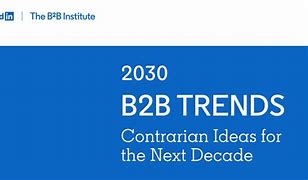Over the past few days I’ve been publishing my precis of the excellent LinkedIn B2B 2030 Trends white paper from Peter Weinberg & Jon Lombardo. Parts 1 and 2 can be found here (A Refocus on B2B Brand as a Long Term Sales Driver | LinkedIn) and here (Blockbusbuster B2B Marketing | LinkedIn). This is part 3: The Death of Hyper Targeting.
Weinberg & Lombardo’s hypothesis is that in B2B marketing, narrow hyper targeting is far less effective than broad targeting.
They cite 5 core reasons to support their hypothesis:
#1 3rd party B2B data is unreliable
The authors cite a recent academic study from MIT, Melbourne Business School and GroupM, in which the researchers decided to test the accuracy of third party B2B data and found that “gender targeting is accurate (only)50% of the time”.
They also found “age targeting (is) accurate 25% of the time”.
Weinberg & Lombardo make the point that the more personalisation criteria a B2B marketer makes in their selection overlays, the less likely the resultant communication is likely to reach the narrowly-targeted audience they think they are reaching.
And with the most basic criteria (age & gender) being unreliable, attempting to sub-targeting by employer, years in role, job title, employer turnover, decision-making authority, marketing budget etc. makes it less and less likely that the targeted audience is being reached.
Why is this important? Because hyper-personalised data is far more expensive to purchase than broadly targeted.
#2 Changing buying networks
The data inefficiencies in reason #1 are amplified by reason #2.
Whilst most first-party data is accurate (e.g. self-identified data purchased from LinkedIn), the temptation is to narrowly target personas whom B2B marketers believe might be the most influential (e.g. procurement managers at aircraft manufacturers).
But this ignores a key aspect of B2B buyer behaviour: the buying cycle for a B2B purchase can often be several years. Crucially, over that time a multitude of new prospects will enter / leave the target decision-making unit.
If you want to reach future buyers, you’ll therefore need to broaden your targeting. Proof? According to LinkedIn’s own data, “Every four years, around 40% of LinkedIn members change their industry, seniority, function and company size.”
The authors conclude that “the best way to catch a moving target is to cast a wide net across many seniorities, functions and industries…Hyper-targeting ignores future buying networks, which imperils future cash flows.”
#3 Multi-dimensionality
Hyper-targeting wrongly assumes that a single B2B decisionmaker is the only valuable audience.
Of course, most B2B purchase decisions are impacted by specifiers, budget-holders, end users, initiators and the rest. Hyper-targeting only the key decision-makers may well mean that your business doesn’t even make the short-list if it’s screened out at an early stage by people you haven’t reached.
As Weinberg and Lombardo point out, there’s a further advantage to broad targeting: “Potential employees, potential partners, potential investors, potential regulators…these are all extremely valuable audiences worth reaching. If you want to hire—and retain—talented employees, get meetings with big buyers and attract great partners, you need to reach all those folks”.
#4 Inherent Uncertainty
The authors assert that “Hyper-targeting assumes a level of predictability that does not exist in the real world…(and)…assumes you know exactly who your buyer is in the first place”.
The truth is that “the vast majority of what buyers do is dark behaviour that’s not trackable, so even the best data will give you an incomplete understanding of reality”. (Indeed in a recent separate LinkedIn report, it’s claimed that businesses that have ‘gated’ thought leadership – i.e. white papers for which the potential reader has to give their contact details before they can access it) often manage to unintentionally screen out potential buyers who are genuinely in the market for the service, but want to retain some control over when a sales representative gets in contact to discuss it).
#5 Imaginary Efficiencies
Weinberg and Lombardo’s simplest argument against hyper-targeting is their math argument: “Hyper-targeting almost always increases media costs. The CPCs and CPMs are much higher for hyper-targeted segments than it is for broadly targeted segments”.
They claim “Even when factoring in a decent amount of wastage, broadly targeted media allows you to reach more of the right buyers at a better price point. You can go too broad at a certain point, but that point is higher than you think”
In summary, the characteristics of the B2B buying process make hyper-targeted messaging grotesquely inefficient:
- The data’s generally poor
- The lengthy buying cycle means individual prospects are constantly entering / leaving the buying arena
- Targeting final decision makers only means you may well end up not even being shortlisted if you haven’t also targeted gatekeepers, influencers, specifiers etc
- Much prospect behaviour is beyond the reach of targeting databases in any case
- The extra fees data owners charge for what they claim is highly-targeted data are generally offset by paying less for more broadly targeted data in any case
Conclusion
The solution is to focus on what the authors call Category Reach.
“You need to reach all potential buyers of the category. Anyone who could buy from you today and in the future, and nonbuying audiences that might work with you in other ways.”
Weinberg and Lombardo point out that “reach is, and always has been, the single greatest predictor of advertising success…Reach matters, in B2B and in B2C”.
This doesn’t mean a complete abandonment of all targeting – today’s trainee brain surgeon is unlikely to ever become an IT decision maker, even at a pharmaceutical company – but targeting too narrowly in B2B can prove both expensive and inefficient.
Simon Hayhurst
January 2021
